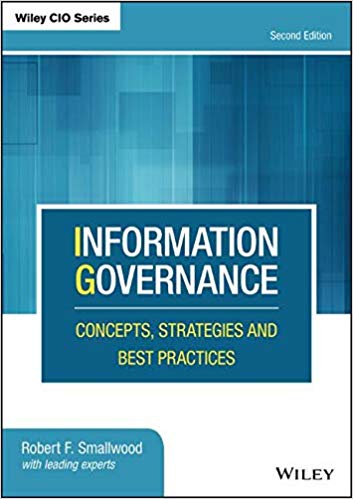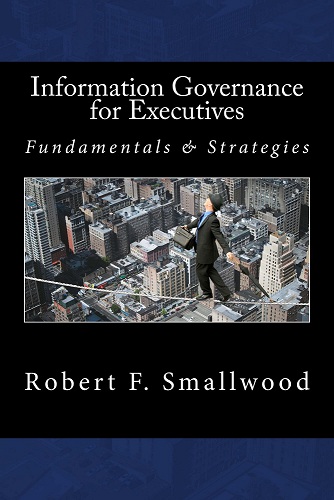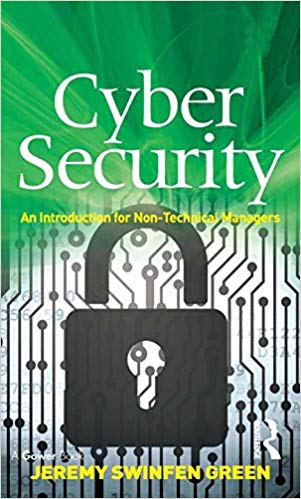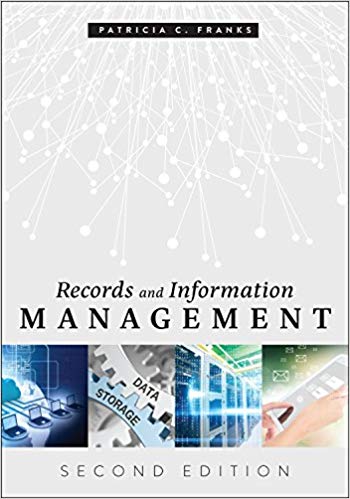
Robert F. Smallwood
Information Governance: Concepts,Strategies, & Best Practicies
Proven and emerging strategies for addressing document and records management risk within the framework of information governance principles and best practices Information Governance (IG) is a rapidly emerging “super discipline” and is now being applied to electronic document and records management, email, social media, cloud computing, mobile computing, and, in fact, the management and output of information organization-wide. IG leverages information technologies to enforce policies, procedures and controls to manage information risk in compliance with legal and litigation demands, external regulatory requirements, and internal governance objectives.Information Governance: Concepts, Strategies, and Best Practices reveals how, and why, to utilize IG and leverage information technologies to control, monitor, and enforce information access and security policies.
- Written by one of the most recognized and published experts on information governance, including specialization in e-document security and electronic records management
- Provides big picture guidance on the imperative for information governance and best practice guidance on electronic document and records management
- Crucial advice and insights for compliance and risk managers, operations managers, corporate counsel, corporate records managers, legal administrators, information technology managers, archivists, knowledge managers, and information governance professionals
IG sets the policies that control and manage the use of organizational information, including social media, mobile computing, cloud computing, email, instant messaging, and the use of e-documents and records. This extends to e-discovery planning and preparation. Information Governance: Concepts, Strategies, and Best Practices provides step-by-step guidance for developing information governance strategies and practices to manage risk in the use of electronic business documents and records.

Douglas B. Laney
INFONOMICS – How to Monetize, Manage, and Measure Information as an Asset for Competitive Advantage
Many senior executives talk about information as one of their most important assets, but few behave as if it is. They report to the board on the health of their workforce, their financials, their customers, and their partnerships, but rarely the health of their information assets. Corporations typically exhibit greater discipline in tracking and accounting for their office furniture than their data.
Infonomics is the theory, study and discipline of asserting economic significance to information. It strives to apply both economic and asset management principles and practices to the valuation, handling, and deployment of information assets. This book specifically shows:
- CEOs and business leaders how to more fully wield information as a corpoate asset
- CIOs how to improve the flow and accessibility of information
- CFOs how to help their organizations measure the actual and latent value in the information assets.
More directly, this book is for the burgeoning force of Chief Data Officers (CDOs) and other information and analytics leaders in their valiant struggle to help their organizations become more infosavvy.
Infonomics can help organizations not only to better develop, sell, and market their offerings, but to transform their organzations altogether.

Robert F. Smallwood
Information Governance for Executives
Information governance (IG)—the ability to secure, control and optimize information—is increasingly seen as a critical initiative in well–run organizations. Executives charged with leading IG programs will benefit from this book, which clearly lays out basic concepts & includes advice from experienced IG leaders.
This book will provide you with crystal-clear definitions of IG and its concepts, give you a high-level understanding of the drivers and benefits of IG, help you develop the business case, and show you how to launch and manage an ongoing IG program. The book answers key questions: What is IG? Why do we need IG? Who should be involved? Where do we start? How dow we implement?
With this book Robert Smallwood, the world’s leading IG author and trainer, lights the path for executives to help streamline their IG approach and avoid bumps in the IG program road. It is a quick read but also a lasting resource.

Jeremy Swinfen Green
Cyber Security An Introduction for Non-Technical Managers
Cyber security involves protecting organisations from cyber risks, the threats to organisations caused by digital technology. These risks can cause direct damage to revenues and profits as well as indirect damage through reduced efficiency, lower employee morale, and reputational damage.
Cyber security is often thought to be the domain of the IT department. However, cyber risks are found across organisations – as well as outside them, for instance in the homes of employees or the business systems of partner organisations. In order to manage these threats, organisations need to take a holistic approach, employing appropriate technology to defend IT systems, but also strengthening business processes and addressing the understanding, motivation and behaviour of employees.
Ultimately, cyber security is the responsibility of every single employee in an organisation from the newest intern to the Chief Executive. Unfortunately, many managers outside IT feel they are ill-equipped to deal with cyber risks or even to question IT specialists, and for this reason the damage from cyber incidents is often worse than it needs to be. This book aims to solve that problem. As well as offering practical advice that does not rely on any understanding of computer code or technology, the author guides readers through the processes that will enable them to identify and manage such threats and ehlp protect their organisations.

Robert F. Smallwood
Managing Electronic Records: Methods, Best Practices, and Technologies
The ultimate guide to electronic records management, featuring a collaboration of expert practitioners including over 400 cited references documenting today’s global trends, standards, and best practices. Nearly all business records created today are electronic, and are increasing in number at breathtaking rates, yet most organizations do not have the policies and technologies in place to effectively organize, search, protect, preserve, and produce these records. Authored by an internationally recognized expert on e-records in collaboration with leading subject matter experts worldwide, this authoritative text addresses the widest range of in-depth e-records topics available in a single volume.
Using guidance from information governance (IG) principles, the book covers methods and best practices for everything from new e-records inventorying techniques and retention schedule development, to taxonomy design, business process improvement, managing vital records, and long term digital preservation. It goes further to include international standards and metadata considerations and then on to proven project planning, system procurement, and implementation methodologies.Managing Electronic Records is filled with current, critical information on e-records management methods, emerging best practices, and key technologies.
- Thoroughly introduces the fundamentals of electronic records management
- Explains the use of ARMA’s Generally Accepted Recordkeeping Principles
- Distills e-records best practices for email, social media, and cloud computing
- Reveals the latest techniques for e-records inventorying and retention scheduling
- Covers MS SharePoint governance planning for e-records including policy guidelines
- Demonstrates how to optimally apply business process improvement techniques
- Makes clear how to implement e-document security strategies and technologies
- Fully presents and discusses long term digital preservation strategies and standards
Managing e-records is a critical area, especially for those organizations faced with increasing regulatory compliance requirements, greater litigation demands, and tightened internal governance. Timely and relevant, Managing Electronic Records reveals step-by-step guidance for organizing, managing, protecting, and preserving electronic records.

Robert F. Smallwood
Information Governance for Healthcare Professionals: A Practical Approach
Like other critical organizational assets, information is a strategic asset that requires high level of oversight in order to be able to effectively use it for organizational decision-making, performance improvement, cost management, and risk mitigation.
Adopting an information governance program shows a healthcare organization’s commitment to managing its information as a valued strategic asset. Information governance serves the dual purpose of optimizing the ability to extract clinical and business value from healthcare information while meeting compliance needs and mitigating risk. Healthcare organizations that have information governance programs will have a competitive edge over others and contributes to safety and quality of care, population health, operational efficiency and effectiveness, and cost reduction initiatives.
This is a much-needed book in the healthcare market space. It will explain, in clear terms, how to develop, launch, and oversee an Information Governance program. It also provides advice and insights from leading IG, cybersecurity and information privacy professionals in healthcare.

Patricia C. Franks
Records and Information Management: Second Edition
Records and Information Management was the first book to provide a lifecycle view of records management that includes both paper and electronic records and information and addresses the impact of Web 2. and records management technologies. The increasingly complex regulatory and legal environment, along with the growing volume and changing nature of records and information created through emerging technologies, continues to bring RIM to the attention of executives who are ultimately responsible the success or failure of their organizations.
The positive reaction by academics and practitioners to the first edition, the continued interest in records and information management (RIM), and the reliance in the field upon emerging technologies supports the need for a second edition. Proposed revisions will bring readers up-to-date on advances in technology, most notably cloud storage, and evolving standards and practices.Because this book has been widely adopted, this revision will be informed by a faculty advisory board (in the hopes of making further inroads into this market). The format of the second edition will closely follow the first, with between 12 and 14 chapters, depending on the input of the book’s advisory board, and each chapter will be followed by a brief piece related to the topic of the chapter that is present as a “perspective” (contributor’s views) or “paradigm” (practical example) written by a practitioner with experience in the field.
We are also trying something relatively new for us, creating an instructor’s packet, which will include PowerPoint slides to accompany the book. Ready-made and editable lecture materials will be a nice incentive for instructors, particularly for beginning instructors and experienced instructors who are teaching this subject for the first time.







